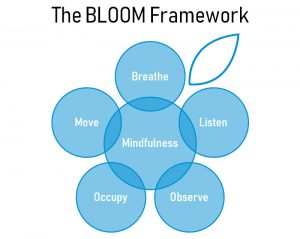Introducing the BLOOM Framework for integrating mindfulness into your busy life.
You’ve been on a couple of courses, downloaded a dozen apps and have an impressive shelf of mindfulness and meditation books – and yet, somehow, you’re still not meditating daily and only using it when you’re megastressed!
Perhaps you find mindfulness boring or just don’t have the motivation to do it or don’t know what to do.
This is why I created the BLOOM Framework.
The following information is provided for attendees of the BLOOM framework training as a reminder of the topics discussed.
BLOOM Overview

Breathe
Examples:
- nostril breathing
- abdominal breathing
- energy breathing
Listen
Examples:
- music
- external noises
Observe
Examples:
- wood grain on desks
- a leaf
- the palm of a hand
Occupy
Examples:
- painting
- mindful eating
- mindful drinking
The trick here is to avoiding trying to do it well. It is very easy to start comparing your artwork to others’ and consequently feel bad about it.
Move
Examples:
- yoga
- mindful walking
As with Occupy, this is also about avoiding trying/striving, and about just enjoying the process.
Summary
- The definition of mindfulness is: to pay attention to the present moment on purpose without judgement. There are many types of meditation and many of these are relaxing but for the full benefits of mindfulness meditation upon which the BLOOM framework is based, any exercises should follow this notion of observing the present and doing this with a sense of non-judgementalism.
- As a reminder, non-judgementalism is simply avoiding judging a situation, what you’re experiencing, what you think about yourself and how you feel. It means noticing without liking or disliking whatever you notice both externally and internally.
- Mindfulness as a specific form of meditation is not just about spending 5 minutes relaxing but brain training to develop focus, concentration, compassion, curiosity, inner calm etc that you can benefit from beyond the 5 minutes of sitting.
- Use the BLOOM framework to vary the exercises.
- Remember the 3 Ts of mindfulness
- Two minutes: keep it short, eg 2 minutes initially (you can increase this over the course of weeks)
- Take your pick of the BLOOM exercises: try different exercises to find what is enjoyable and/or easy (different people like different exercises)
- Time of day: try different times of the day
- During a meditation, remember to practice accepting or being non-judgemental – to not like or dislike whatever you are noticing.
Next Step
You are invited to sign up for our free online mindfulness course, Five Steps to Inner calm, where you will get the opportunity to follow a couple of guided meditations and have a go at our 7 day challenge! To find out more about this free course, please visit: wimble.com/free
